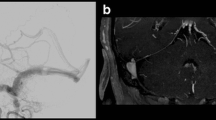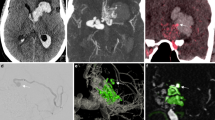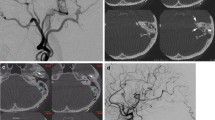Abstract
Purpose
Previously published data demonstrated the possibility of displaying the angioarchitecture of intracranial vascular malformations using time-resolved 3D imaging (4D digital subtraction angiography [DSA]). The purpose of our study was to prove the technical feasibility of creating fused images of time-resolved 3D reconstructions and MPRAGE MRI data sets and to check the reliability of the correct anatomical display of the angioma nidus and the venous drainage in the fused images of patients with intracranial arteriovenous malformations (AVM).
Patients and Methods
In this study 20 patients with intracranial AVM underwent pretherapeutic DSA and time-resolved 3D DSA in addition to MRI including MPRAGE sequences. The images were post-processed with the fusion software tool on a dedicated research workstation. The fusion of both imaging modalities was done semi-automatically with automatic co-registration software followed by a manual co-registration.
Results
Co-registered DSA/MRI data sets of 20 untreated AVMs were evaluated independently by two reviewers. Image fusion was successful in all 20 cases with an acceptable additional set-up time. The fused images were highly scored by the two raters in respect to their congruency of the dedicated regions. Precise anatomical localization of the nidus, the feeding arteries and the draining veins were possible with the merged images.
Conclusion
Creating fused images of time-resolved 3D DSA and contrast-enhanced T1-weighted MPRAGE MR images might be beneficial for the preoperative and intrasurgical workflow in patients with AVMs. This new software tool fulfils the required quality and accuracy of the merged images. The clinical validation has to be proven in further studies.



Similar content being viewed by others
References
Perhac J, Spaltenstein J, Pereira VM, Schaller K, Brina O, Cabrilo I, Ratib O. Improving workflows of neuro-interventional procedures with autostereoscopic 3D visualization of multi-modality imaging in hybrid interventional suites. Int J Comput Assist Radiol Surg. 2016;11(2):189–96.
Suzuki H, Maki H, Taki W. Evaluation of cerebral arteriovenous malformations using image fusion combining three-dimensional digital subtraction angiography with magnetic resonance imaging. Turk Neurosurg. 2012;22(3):341–5.
Starke RM, Komotar RJ, Hwang BY, Fischer LE, Garrett MC, Otten ML, Connolly ES. Treatment guidelines for cerebral arteriovenous malformation microsurgery. Br J Neurosurg. 2009;23(4):376–86.
Bekelis K, Missios S, Desai A, Eskey C, Erkmen K. Magnetic resonance imaging/magnetic resonance angiography fusion technique for intraoperative navigation during microsurgical resection of cerebral arteriovenous malformations. Neurosurg Focus. 2012;32(5):E7.
Sandoval-Garcia C, Royalty K, Yang P, Niemann D, Ahmed A, Aagaard-Kienitz B, Başkaya MK, Schafer S, Strother C. 4D DSA a new technique for arteriovenous malformation evaluation: a feasibility study. J Neurointerv Surg. 2016;8(3):300–4.
Lescher S, Gehrisch S, Klein S, Berkefeld J. Time-resolved 3D rotational angiography: display of detailed neurovascular anatomy in patients with intracranial vascular malformations. J Neurointerv Surg. 2016 Aug 4. [Epub ahead of print]
Shimizu S, Suzuki H, Maki H, Maeda M, Miya F, Benali K, Trousset Y, Taki W. A novel image fusion visualizes the angioarchitecture of the perforating arteries in the brain. AJNR Am J Neuroradiol. 2003;24(10):2011–4.
Suzuki H, Maki H, Maeda M, Shimizu S, Trousset Y, Taki W. Visualization of the intracisternal angioarchitecture at the posterior fossa by use of image fusion. Neurosurgery. 2005;56(2):335–42, discussion 335–42.
Suzuki H, Shimizu S, Maki H, Maeda M, Sakaida H, Trousset Y, Taki W. Role of image fusion combining three-dimensional digital subtraction angiography with magnetic resonance imaging in evaluation of unruptured cerebral aneurysms. Neurol Res. 2007;29(1):58–63.
Sandoval-Garcia C, Royalty K, Aagaard-Kienitz B, Schafer S, Yang P, Strother C. A comparison of 4D DSA with 2D and 3D DSA in the analysis of normal vascular structures in a canine model. AJNR Am J Neuroradiol. 2015;36(10):1959–63.
McGee KP, Ivanovic V, Felmlee JP, Meyer FB, Pollock BE, Huston J. MR angiography fusion technique for treatment planning of intracranial arteriovenous malformations. J Magn Reson Imaging. 2006;23(3):361–9.
Blanc R, Seiler A, Robert T, Baharvahdat H, Lafarge M, Savatovsky J, Hodel J, Ciccio G, Chauvet D, Pistocchi S, Bartolini B, Redjem H, Piotin M. Multimodal angiographic assessment of cerebral arteriovenous malformations: a pilot study. J Neurointerv Surg. 2015;7(11):841–7.
Heidenreich JO, Schilling AM, Unterharnscheidt F, Stendel R, Hartlieb S, Wacker FK, Schlattmann P, Wolf KJ, Bruhn H. Assessment of 3D-TOF-MRA at 3.0 Tesla in the characterization of the angioarchitecture of cerebral arteriovenous malformations: a preliminary study. Acta Radiol. 2007;48(6):678–86.
Nasel C. Visualization of intracranial vessel anatomy using high resolution MRI and a simple image fusion technique. Eur J Radiol. 2005;54(1):107–11.
Du R, Keyoung HM, Dowd CF, Young WL, Lawton MT. The effects of diffuseness and deep perforating artery supply on outcomes after microsurgical resection of brain arteriovenous malformations. Neurosurgery. 2007;60(4):638–48.
Author information
Authors and Affiliations
Corresponding author
Ethics declarations
Conflict of interest
B. Ommer, V. Seifert and J. Konczalla declare that they have no competing interests. J. Berkefeld: Consulting Fee or Honorarium: proctor for WEB, Sequent Medical and member of the scientific advisory board of Acandis. J. Berkefeld and S. Tritt: The project is part of a permanent scientific cooperation between Siemens and the Institute of Neuroradiology at the University Frankfurt, Germany, and travel expenses for presentation of the project are covered by Siemens. Our institution will receive a honorarium related to the publication of the study from Siemens. S. Gehrisch and S. Klein: Employee of Siemens Healthcare GmbH, BU Advanced Therapies, Forchheim, Germany.
Ethical standards
All procedures performed in studies involving human participants were in accordance with the ethical standards of the institutional and/or national research committee and with the 1964 Helsinki declaration and its later amendments or comparable ethical standards. Informed consent was obtained from all individual participants included in the study.
Rights and permissions
About this article
Cite this article
Tritt, S., Ommer, B., Gehrisch, S. et al. Optimization of the Surgical Approach in AVMs Using MRI and 4D DSA Fusion Technique. Clin Neuroradiol 27, 443–450 (2017). https://doi.org/10.1007/s00062-017-0571-2
Received:
Accepted:
Published:
Issue Date:
DOI: https://doi.org/10.1007/s00062-017-0571-2




